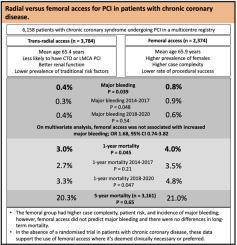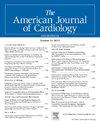慢性冠心病患者经皮冠状动脉介入治疗的桡动脉与股动脉通路
IF 2.1
3区 医学
Q2 CARDIAC & CARDIOVASCULAR SYSTEMS
引用次数: 0
摘要
指南推荐所有经皮冠状动脉介入治疗(PCI)的经桡动脉通路(TRA)。然而,没有随机试验表明在慢性冠状动脉疾病中,与股入路相比,股入路的死亡率更低,在某些情况下,股入路可能是首选。纳入了2014 - 2020年间多中心登记的连续符合条件的患者。比较了桡骨入路与股骨入路的临床特征和结果。主要结局为大出血和5年死亡率。在纳入的6158例患者中,3784例(61.4%)有TRA, 2374例(38.6%)有股骨通路。TRA从2016年开始占据主导地位。股骨组糖尿病、肾功能不全及既往脑卒中发生率较高。经股手术更为复杂,ACC/AHA B2/C型病变发生率较高,慢性全闭塞,左主干PCI,使用包括旋转动脉粥样硬化切除术在内的辅助手段,手术成功率较低。股骨组大出血发生率较高(桡骨0.4% vs股骨0.8%,p = 0.039),但股骨通路不能预测大出血(OR 1.68, 95% CI 0.74-3.82)。5年死亡率无差异(桡骨20.3% vs股骨21%,p = 0.65)。总之,TRA在当代CCD的PCI治疗中占主导地位。股骨组手术复杂性和风险较高,术中大出血发生率较高。尽管如此,股骨通路不能预测大出血,与TRA相比,5年死亡率没有差异。在缺乏当代随机试验的情况下,如果临床上首选慢性冠状动脉疾病患者行PCI,则股动脉入路似乎是合理的。本文章由计算机程序翻译,如有差异,请以英文原文为准。

Radial Versus Femoral Access for Percutaneous Coronary Intervention in Patients With Chronic Coronary Disease
Guidelines recommend trans-radial access (TRA) for all percutaneous coronary intervention (PCI). However, no randomized trials have shown a lower mortality when compared to the femoral approach in chronic coronary disease and femoral access may be preferred in certain situations. Consecutive eligible patients in a multi-center registry between 2014 – 2020 were included. Clinical characteristics and outcomes were compared between those who underwent radial versus femoral access. The main outcomes were major bleeding and 5-year mortality. Of the 6,158 patients included, 3,784 (61.4%) had TRA and 2,374 (38.6%) femoral access. TRA predominated from 2016. The femoral group had higher rates of diabetes mellitus, renal dysfunction and prior stroke. Trans-femoral procedures were more complex with higher rates of ACC/AHA type B2/C lesions, chronic total occlusions, left main PCI, use of adjuvants including rotational atherectomy, and lower procedural success rates. Major bleeding was higher in the femoral group (radial 0.4% vs femoral 0.8%, p = 0.039), however femoral access did not predict major bleeding (OR 1.68, 95% CI 0.74 to 3.82). There was no difference in 5-year mortality (radial 20.3% vs femoral 21%, p = 0.65). In conclusion, TRA predominates in contemporary PCI for CCD. The femoral group had higher procedural complexity and risk with a higher incidence of peri‑procedural major bleeding. Nonetheless, femoral access did not predict major bleeding and there was no difference in 5-year mortality as compared to TRA. In the absence of a contemporary randomized trial, the femoral approach appears reasonable if clinically preferred in patients with chronic coronary disease undergoing PCI.
求助全文
通过发布文献求助,成功后即可免费获取论文全文。
去求助
来源期刊

American Journal of Cardiology
医学-心血管系统
CiteScore
4.00
自引率
3.60%
发文量
698
审稿时长
33 days
期刊介绍:
Published 24 times a year, The American Journal of Cardiology® is an independent journal designed for cardiovascular disease specialists and internists with a subspecialty in cardiology throughout the world. AJC is an independent, scientific, peer-reviewed journal of original articles that focus on the practical, clinical approach to the diagnosis and treatment of cardiovascular disease. AJC has one of the fastest acceptance to publication times in Cardiology. Features report on systemic hypertension, methodology, drugs, pacing, arrhythmia, preventive cardiology, congestive heart failure, valvular heart disease, congenital heart disease, and cardiomyopathy. Also included are editorials, readers'' comments, and symposia.
 求助内容:
求助内容: 应助结果提醒方式:
应助结果提醒方式:


